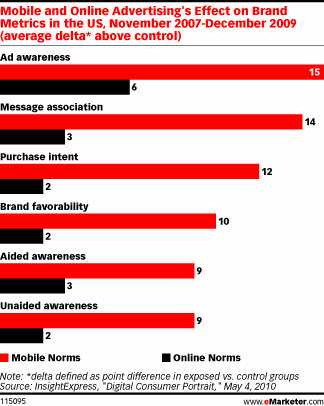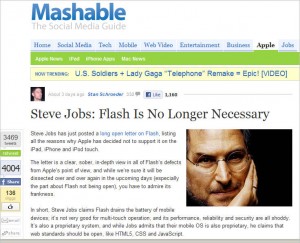 Comparative advertising has been making a comeback in recent years with the Progresso vs. Campbell’s soup comparative ad campaign bringing back memories of the Coke vs. Pepsi challenge from decades earlier. This week, Adobe and Apple have jumped on the comparative advertising bandwagon but with a catch. Instead of trying to differentiate two brands or products, Adobe’s “We Love Apple” ad, which is part of its “Freedom of Choice” campaign, attacks a business decision made by Apple which Steve Jobs communicated quite clearly recently — Apple’s mobile devices, including the iPad and iPhone, do not and will never support Flash.
Comparative advertising has been making a comeback in recent years with the Progresso vs. Campbell’s soup comparative ad campaign bringing back memories of the Coke vs. Pepsi challenge from decades earlier. This week, Adobe and Apple have jumped on the comparative advertising bandwagon but with a catch. Instead of trying to differentiate two brands or products, Adobe’s “We Love Apple” ad, which is part of its “Freedom of Choice” campaign, attacks a business decision made by Apple which Steve Jobs communicated quite clearly recently — Apple’s mobile devices, including the iPad and iPhone, do not and will never support Flash.
The Adobe ad making the rounds across the social Web this week is pictured above and includes copy that says Adobe loves creativity and flash, but, “What we don’t love is anybody taking away your freedom to choose what you create, how you create it, and what you experience on the Web.”
According to Adobe, the campaign is intended to defend consumers’ freedom of choice claiming that big companies with deep pockets shouldn’t be able to dictate the content people can view online, and since 75% of online video content still uses Flash, that’s exactly what Apple is doing by refusing to support Flash on its mobile devices.
Of course, tech-enthusiasts argue that Flash is “old school” and it’s only a matter of time until it’s completely replaced with better technology. However, Adobe has a point. The change from Flash hasn’t happened yet, and it’s unlikely to happen overnight. Regardless of whether or not the technology is appropriate for mobile devices, people will still want to use it until it’s completely replaced across the Web. Considering that the vast majority of online video is viewed on YouTube, and YouTube still relies on Flash, Apple is denying access to a big chunk of online content that iPad and iPhone customers would probably like to view.
What do you think? Which side of the debate do you stand on? Should Apple support Flash on its mobile devices or should consumers understand that Flash technology needs to be replaced on mobile devices, so they’ll need to live without access to Flash content until the shift to that new technology is made across the Web? In the meantime, which brand looks better or worse in this feud? Is Apple a bully or is Adobe a sore loser? Leave a comment and share your thoughts.


 For years,
For years, 
